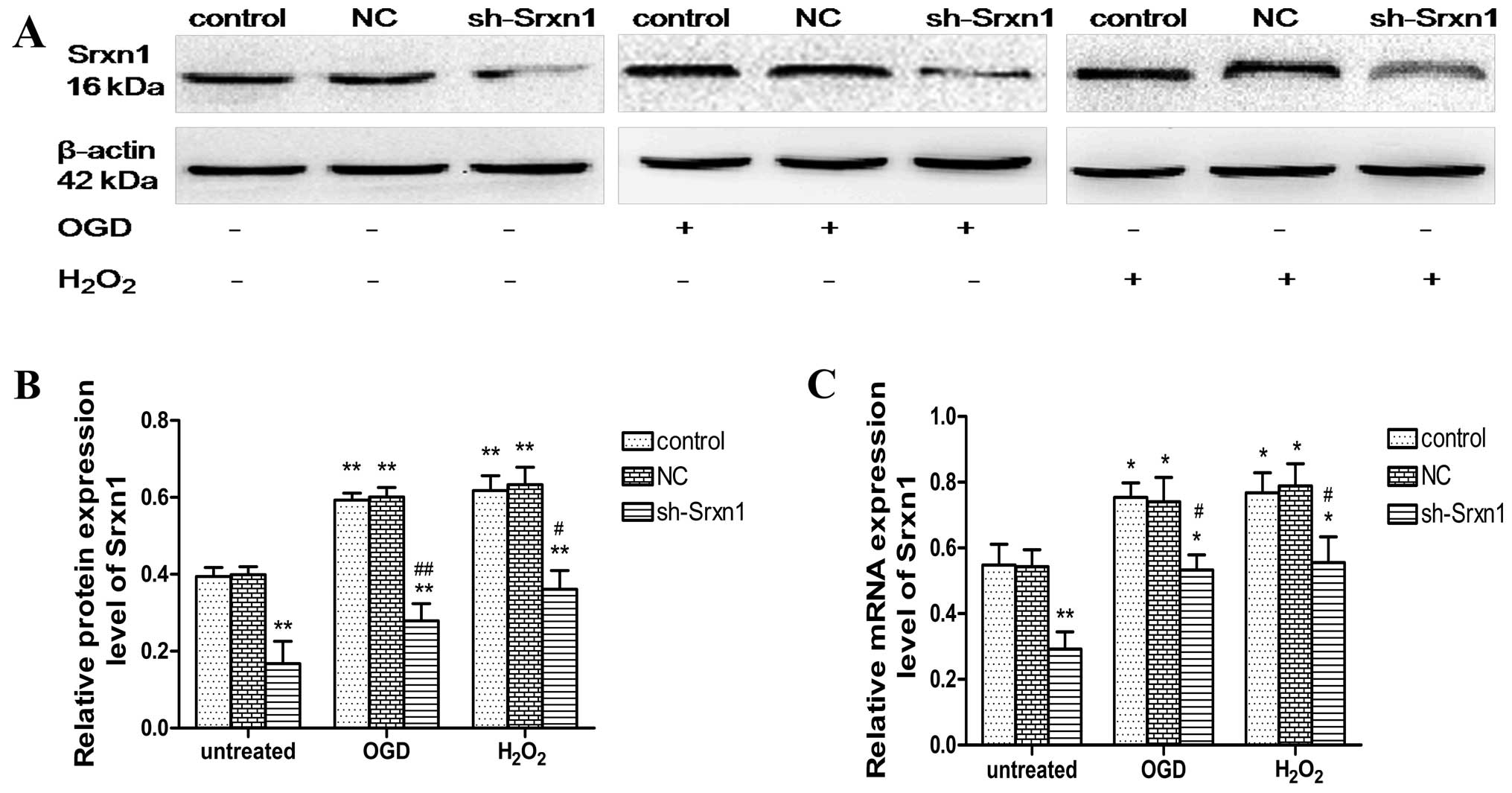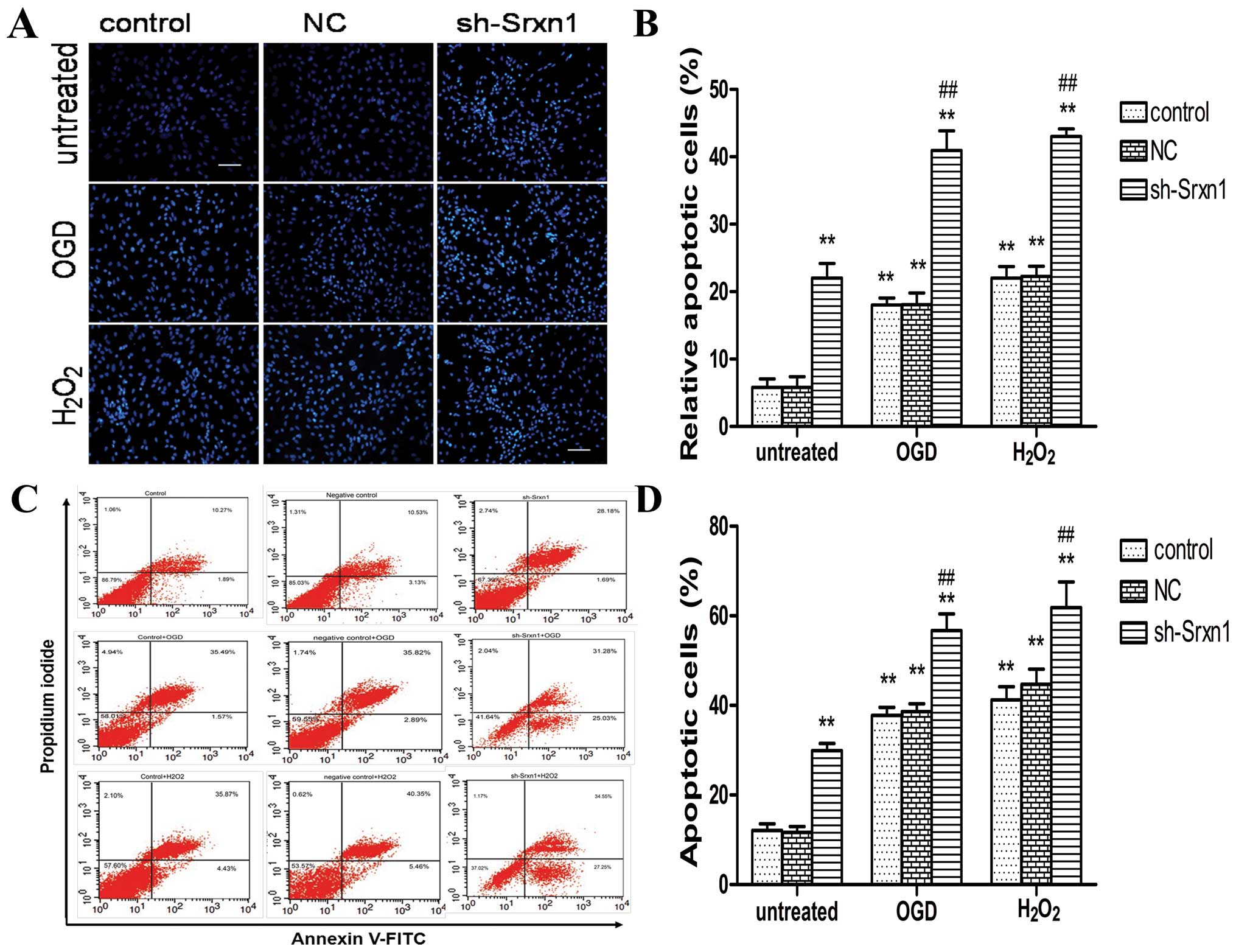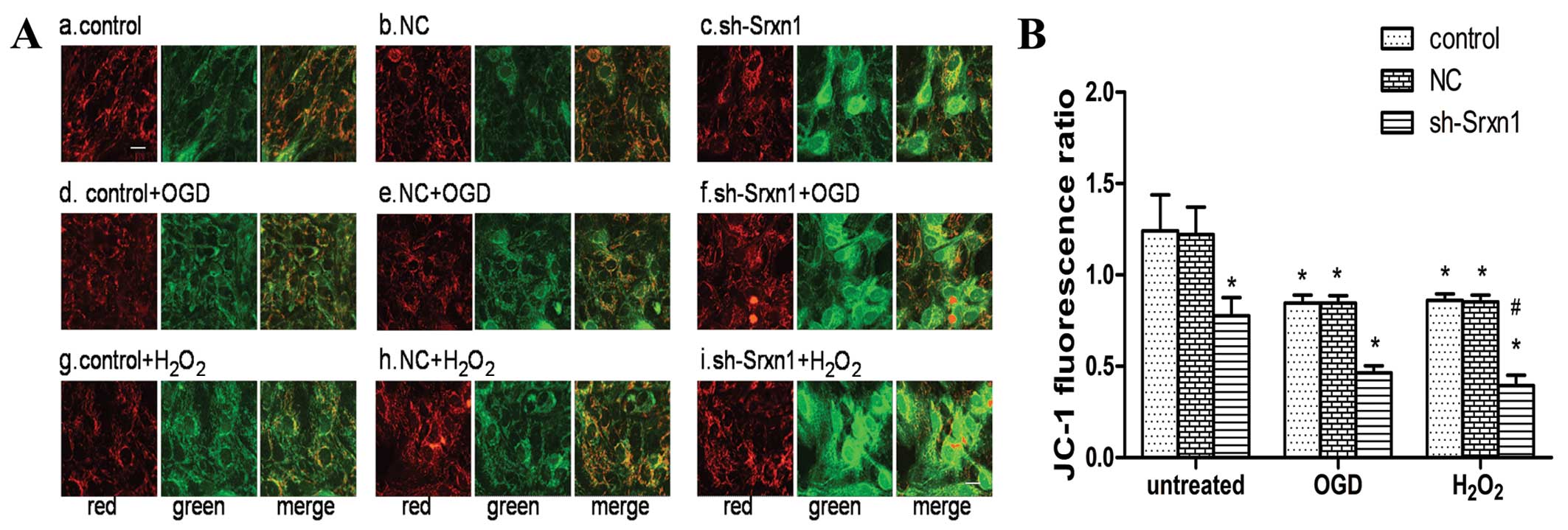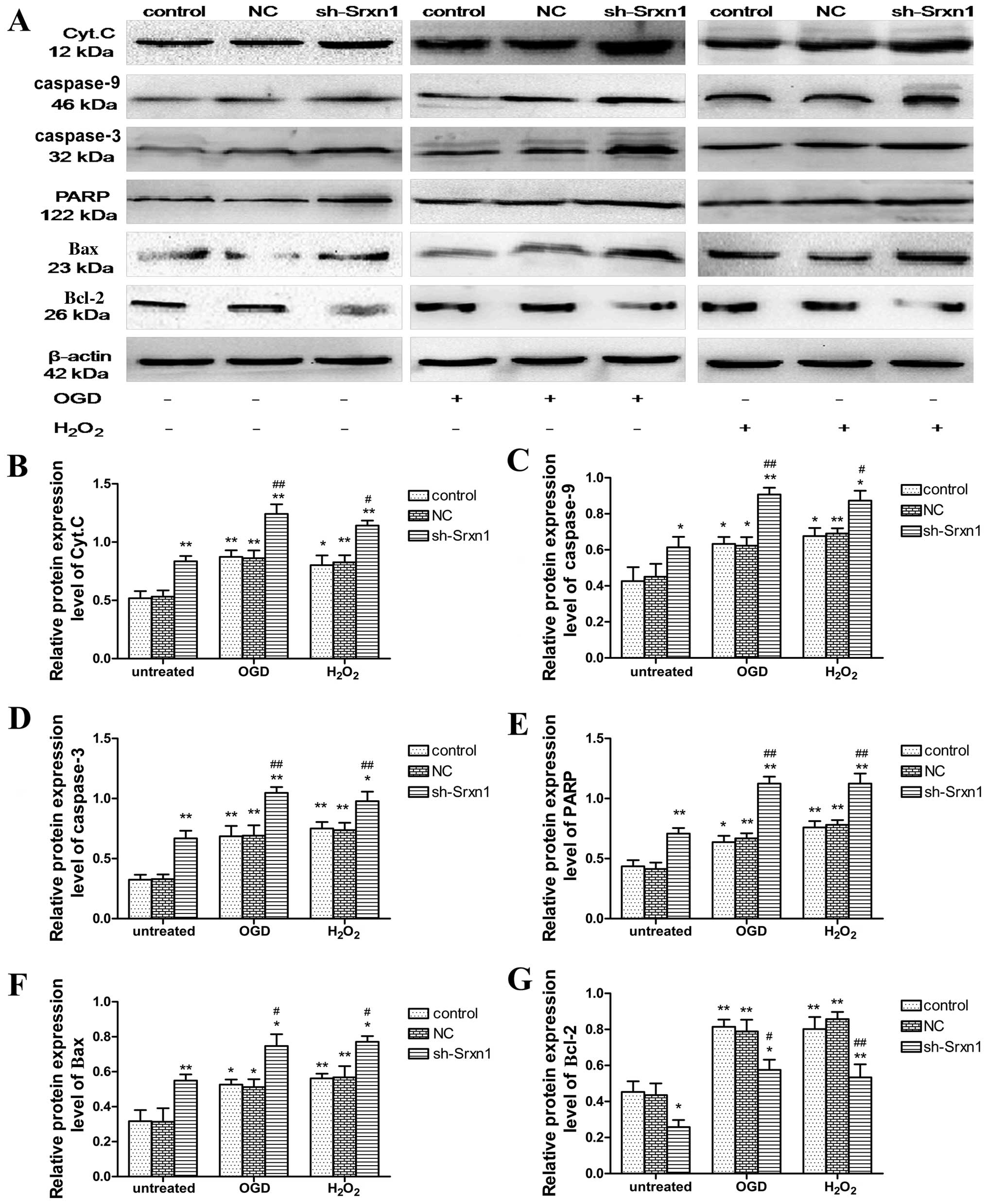|
1
|
Li Q, Yu S, Wu J, Zou Y and Zhao Y:
Sulfiredoxin-1 protects PC12 cells against oxidative stress induced
by hydrogen peroxide. J Neurosci Res. 91:861–870. 2013. View Article : Google Scholar : PubMed/NCBI
|
|
2
|
Kinsner A, Pilotto V, Deininger S, et al:
Inflammatory neurodegeneration induced by lipoteichoic acid from
Staphylococcus aureus is mediated by glia activation, nitrosative
and oxidative stress, and caspase activation. J Neurochem.
95:1132–1143. 2005. View Article : Google Scholar : PubMed/NCBI
|
|
3
|
Papadia S, Soriano FX, Leveille F, et al:
Synaptic NMDA receptor activity boosts intrinsic antioxidant
defenses. Nat Neurosci. 11:476–487. 2008. View Article : Google Scholar : PubMed/NCBI
|
|
4
|
Biteau B, Labarre J and Toledano MB:
ATP-dependent reduction of cysteine-sulphinic acid by S. cerevisiae
sulphiredoxin. Nature. 425:980–984. 2003. View Article : Google Scholar : PubMed/NCBI
|
|
5
|
Rhee SG, Jeong W, Chang TS and Woo HA:
Sulfiredoxin, the cysteine sulfinic acid reductase specific to
2-Cys peroxiredoxin: its discovery, mechanism of action, and
biological significance. Kidney Int Suppl. 72:S3–S8. 2007.
View Article : Google Scholar
|
|
6
|
Vivancos AP, Castillo EA, Biteau B, et al:
A cysteine-sulfinic acid in peroxiredoxin regulates
H2O2-sensing by the antioxidant Pap1 pathway.
Proc Natl Acad Sci USA. 102:8875–8880. 2005. View Article : Google Scholar
|
|
7
|
Findlay VJ, Tapiero H and Townsend DM:
Sulfiredoxin: a potential therapeutic agent? Biomed Pharmacother.
59:374–379. 2005. View Article : Google Scholar : PubMed/NCBI
|
|
8
|
Soriano FX, Leveille F, Papadia S, et al:
Induction of sulfiredoxin expression and reduction of peroxiredoxin
hyperoxidation by the neuroprotective Nrf2 activator
3H-1,2-dithiole-3-thione. J Neurochem. 107:533–543. 2008.
View Article : Google Scholar : PubMed/NCBI
|
|
9
|
Kang KW, Lee SJ and Kim SG: Molecular
mechanism of nrf2 activation by oxidative stress. Antioxid Redox
Signal. 7:1664–1673. 2005. View Article : Google Scholar : PubMed/NCBI
|
|
10
|
Singh A, Ling G, Suhasini AN, et al:
Nrf2-dependent sulfiredoxin-1 expression protects against cigarette
smoke-induced oxidative stress in lungs. Free Radic Biol Med.
46:376–386. 2009. View Article : Google Scholar
|
|
11
|
Bell KF, Al-Mubarak B, Fowler JH, et al:
Mild oxidative stress activates Nrf2 in astrocytes, which
contributes to neuroprotective ischemic preconditioning. Proc Natl
Acad Sci USA. 108:E1–E2. 2011. View Article : Google Scholar :
|
|
12
|
Noh YH, Baek JY, Jeong W, Rhee SG and
Chang TS: Sulfiredoxin translocation into mitochondria plays a
crucial role in reducing hyperoxidized peroxiredoxin III. J Biol
Chem. 284:8470–8477. 2009. View Article : Google Scholar : PubMed/NCBI
|
|
13
|
Baek JY, Han SH, Sung SH, et al:
Sulfiredoxin protein is critical for redox balance and survival of
cells exposed to low steady-state levels of
H2O2. J Biol Chem. 287:81–89. 2012.
View Article : Google Scholar :
|
|
14
|
Wu J, Li Q, Wang X, et al: Neuroprotection
by curcumin in ischemic brain injury involves the Akt/Nrf2 pathway.
PLoS One. 8:e598432013. View Article : Google Scholar : PubMed/NCBI
|
|
15
|
Wu X, Zhao J, Yu S, Chen Y, Wu J and Zhao
Y: Sulforaphane protects primary cultures of cortical neurons
against injury induced by oxygen-glucose deprivation/reoxygenation
via anti-apoptosis. Neurosci Bull. 28:509–516. 2012. View Article : Google Scholar : PubMed/NCBI
|
|
16
|
Liu SB, Zhang N, Guo YY, et al:
G-protein-coupled receptor 30 mediates rapid neuroprotective
effects of estrogen via depression of NR2B-containing NMDA
receptors. J Neurosci. 32:4887–4900. 2012. View Article : Google Scholar : PubMed/NCBI
|
|
17
|
Schmittgen TD and Livak KJ: Analyzing
real-time PCR data by the comparative C(T) method. Nat Protoc.
3:1101–1108. 2008. View Article : Google Scholar : PubMed/NCBI
|
|
18
|
Song S, Zhou J, He S, et al: Expression
levels of microRNA-375 in pancreatic cancer. Biomed Rep. 1:393–398.
2013.
|
|
19
|
Lin CJ, Chen TH, Yang LY and Shih CM:
Resveratrol protects astrocytes against traumatic brain injury
through inhibiting apoptotic and autophagic cell death. Cell Death
Dis. 5:e11472014. View Article : Google Scholar : PubMed/NCBI
|
|
20
|
Han F, Tao RR, Zhang GS, et al: Melatonin
ameliorates ischemic-like injury-evoked nitrosative stress:
Involvement of HtrA2/PED pathways in endothelial cells. J Pineal
Res. 50:281–291. 2011. View Article : Google Scholar : PubMed/NCBI
|
|
21
|
Sung DK, Chang YS, Kang S, Song HY, Park
WS and Lee BH: Comparative evaluation of hypoxic-ischemic brain
injury by flow cytometric analysis of mitochondrial membrane
potential with JC-1 in neonatal rats. J Neurosci Methods.
193:232–238. 2010. View Article : Google Scholar : PubMed/NCBI
|
|
22
|
Zhao J, Kobori N, Aronowski J and Dash PK:
Sulforaphane reduces infarct volume following focal cerebral
ischemia in rodents. Neurosci Lett. 393:108–112. 2006. View Article : Google Scholar
|
|
23
|
Chan PH: Reactive oxygen radicals in
signaling and damage in the ischemic brain. J Cereb Blood Flow
Metab. 21:2–14. 2001. View Article : Google Scholar : PubMed/NCBI
|
|
24
|
Hossain MA: Hypoxic-ischemic injury in
neonatal brain: involvement of a novel neuronal molecule in
neuronal cell death and potential target for neuroprotection. Int J
Dev Neurosci. 26:93–101. 2008. View Article : Google Scholar
|
|
25
|
Kawamura M, Nakajima W, Ishida A, Ohmura
A, Miura S and Takada G: Calpain inhibitor MDL 28170 protects
hypoxic-ischemic brain injury in neonatal rats by inhibition of
both apoptosis and necrosis. Brain Res. 1037:59–69. 2005.
View Article : Google Scholar : PubMed/NCBI
|
|
26
|
Northington FJ, Graham EM and Martin LJ:
Apoptosis in perinatal hypoxic-ischemic brain injury: how important
is it and should it be inhibited? Brain Res Brain Res Rev.
50:244–257. 2005. View Article : Google Scholar : PubMed/NCBI
|
|
27
|
Stellwagen D and Malenka RC: Synaptic
scaling mediated by glial TNF-alpha. Nature. 440:1054–1059. 2006.
View Article : Google Scholar : PubMed/NCBI
|
|
28
|
Perea G, Yang A, Boyden ES and Sur M:
Optogenetic astrocyte activation modulates response selectivity of
visual cortex neurons in vivo. Nat Commun. 5:32622014. View Article : Google Scholar : PubMed/NCBI
|
|
29
|
Lopez-Hidalgo M and Schummers J: Cortical
maps: a role for astrocytes? Curr Opin Neurobiol. 24:176–189. 2014.
View Article : Google Scholar : PubMed/NCBI
|
|
30
|
Giffard RG and Swanson RA:
Ischemia-induced programmed cell death in astrocytes. Glia.
50:299–306. 2005. View Article : Google Scholar : PubMed/NCBI
|
|
31
|
Yu AC, Wong HK, Yung HW and Lau LT:
Ischemia-induced apoptosis in primary cultures of astrocytes. Glia.
35:121–130. 2001. View Article : Google Scholar : PubMed/NCBI
|
|
32
|
Wang J, Deng X, Zhang F, Chen D and Ding
W: ZnO nanoparticle-induced oxidative stress triggers apoptosis by
activating JNK signaling pathway in cultured primary astrocytes.
Nanoscale Res Lett. 9:1172014. View Article : Google Scholar : PubMed/NCBI
|
|
33
|
Xie Z, Smith CJ and Van Eldik LJ:
Activated glia induce neuron death via MAP kinase signaling
pathways involving JNK and p38. Glia. 45:170–179. 2004. View Article : Google Scholar : PubMed/NCBI
|
|
34
|
Takuma K, Baba A and Matsuda T: Astrocyte
apoptosis: implications for neuroprotection. Prog Neurobiol.
72:111–127. 2004. View Article : Google Scholar : PubMed/NCBI
|
|
35
|
Desagher S and Martinou JC: Mitochondria
as the central control point of apoptosis. Trends Cell Biol.
10:369–377. 2000. View Article : Google Scholar : PubMed/NCBI
|
|
36
|
Wang X: The expanding role of mitochondria
in apoptosis. Genes Dev. 15:2922–2933. 2001.PubMed/NCBI
|
|
37
|
Sun XM, MacFarlane M, Zhuang J, Wolf BB,
Green DR and Cohen GM: Distinct caspase cascades are initiated in
receptor-mediated and chemical-induced apoptosis. J Biol Chem.
274:5053–5060. 1999. View Article : Google Scholar : PubMed/NCBI
|
|
38
|
Ferri KF and Kroemer G: Organelle-specific
initiation of cell death pathways. Nat Cell Biol. 3:E255–E263.
2001. View Article : Google Scholar : PubMed/NCBI
|
|
39
|
Nakagawa T, Zhu H, Morishima N, et al:
Caspase-12 mediates endoplasmic-reticulum-specific apoptosis and
cytotoxicity by amyloid-beta. Nature. 403:98–103. 2000. View Article : Google Scholar : PubMed/NCBI
|
|
40
|
Leist M and Nicotera P: Apoptosis,
excitotoxicity, and neuropathology. Exp Cell Res. 239:183–201.
1998. View Article : Google Scholar : PubMed/NCBI
|
|
41
|
Iijima T, Mishima T, Akagawa K and Iwao Y:
Mitochondrial hyperpolarization after transient oxygen-glucose
deprivation and subsequent apoptosis in cultured rat hippocampal
neurons. Brain Res. 993:140–145. 2003. View Article : Google Scholar : PubMed/NCBI
|
|
42
|
Ye R, Li N, Han J, et al: Neuroprotective
effects of ginsenoside Rd against oxygen-glucose deprivation in
cultured hippocampal neurons. Neurosci Res. 64:306–310. 2009.
View Article : Google Scholar : PubMed/NCBI
|
|
43
|
Acehan D, Jiang X, Morgan DG, Heuser JE,
Wang X and Akey CW: Three-dimensional structure of the apoptosome:
implications for assembly, procaspase-9 binding, and activation.
Mol Cell. 9:423–432. 2002. View Article : Google Scholar : PubMed/NCBI
|
|
44
|
Ji YB, Qu ZY and Zou X: Juglone-induced
apoptosis in human gastric cancer SGC-7901 cells via the
mitochondrial pathway. Exp Toxicol Pathol. 63:69–78. 2011.
View Article : Google Scholar
|
|
45
|
Khan M, Ding C, Rasul A, et al:
Isoalantolactone induces reactive oxygen species mediated apoptosis
in pancreatic carcinoma PANC-1 cells. Int J Biol Sci. 8:533–547.
2012. View Article : Google Scholar : PubMed/NCBI
|
|
46
|
Wong WW and Puthalakath H: Bcl-2 family
proteins: the sentinels of the mitochondrial apoptosis pathway.
IUBMB Life. 60:390–397. 2008. View
Article : Google Scholar : PubMed/NCBI
|
|
47
|
Moldoveanu T, Follis AV, Kriwacki RW and
Green DR: Many players in BCL-2 family affairs. Trends Biochem Sci.
39:101–111. 2014. View Article : Google Scholar : PubMed/NCBI
|
|
48
|
Martinou JC and Youle RJ: Mitochondria in
apoptosis: Bcl-2 family members and mitochondrial dynamics. Dev
Cell. 21:92–101. 2011. View Article : Google Scholar : PubMed/NCBI
|
|
49
|
Shacka JJ and Roth KA: Regulation of
neuronal cell death and neurodegeneration by members of the Bcl-2
family: therapeutic implications. Curr Drug Targets CNS Neurol
Disord. 4:25–39. 2005. View Article : Google Scholar : PubMed/NCBI
|
|
50
|
Szegezdi E, Fitzgerald U and Samali A:
Caspase-12 and ER-stress-mediated apoptosis: the story so far. Ann
NY Acad Sci. 1010:186–194. 2003. View Article : Google Scholar
|
|
51
|
Sergeev IN: Calcium signaling in cancer
and vitamin D. J Steroid Biochem Mol Biol. 97:145–151. 2005.
View Article : Google Scholar : PubMed/NCBI
|















